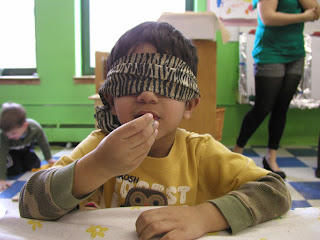The children really enjoyed our Smell and Taste Tests during freeplay this week.
The Smell Station had five different smells: cinnamon, seaweed, chocolate, vanilla, and mint. Many of the children were able to identify the smell, or name a related food product. For mint, some suggested dental floss or toothpaste. For cinnamon, they said cookies or french fries, and for seaweed, some said fish. Can you tell which one Daria is smelling below?




We talked about how smell and taste work together to give us clues about something, and had great conversations about nostrils and their function. The book "The Holes In Your Nose" by Genichiro Yagyu is a great resource, filled with facts and a bit silly (in a good way).
Our Taste Table featured raisins, rice krispies, sliced peaches, pickles, lemons, and cinnamon. These choices covered many different textures and flavors: chewy, crunchy, sweet, sour, tart. The children were asked to wear a blindfold and describe what they thought they were eating, using as many descriptive words as possible. As you might have guessed, the pickles and lemons were only favored by a few students, while the rest expressed their disgust appropriately.





We also made our own toothpaste this week, using baking soda (4 tsp), salt (1/2 tsp), water (3 tsp), and mint extract (3 drops). The children really enjoyed this activity, and many were excited to try it out at home. We have talked about when is a good time to brush, why we need to brush, and how long ago, toothbrush bristles were made out of hog hair. Yummy!!

We continued to paint with our feet (one child likened the slippery experience to ice skating).

We also had two special mommy guests this week. Sally, a physician, came in to talk to the children about the heart, lungs, breathing, and ribs, among other bodily items. We learned about lungs function like balloons, filling up with air and letting it out, we listened to heart beats on the stereo, and even got to use her stethoscope to listen to each other's hearts in real time. She taught us that a stethoscope can also be used to listen to air going in and out of your lungs. Sally also brought in a device that lets you see how much air your lungs can hold. We were also able to examine a real X-ray of the human chest, with the ribs clearly visible. We discussed how ribs protect the important organs in our chest.





Jen helped us finish our delicious flower pot project. We used cupcakes, frosting, and edible rocks to look like soil, threw some gummy worms on top, and made our own flowers from tissue paper and pipe cleaners. As we were making them, you could see the children trying to restrain from having an early taste of their work, and even saw a few sneak a quick lick of frosting or a nibble of a chocolate rock. They love their sweets!



See you all at conferences!!
No comments:
Post a Comment